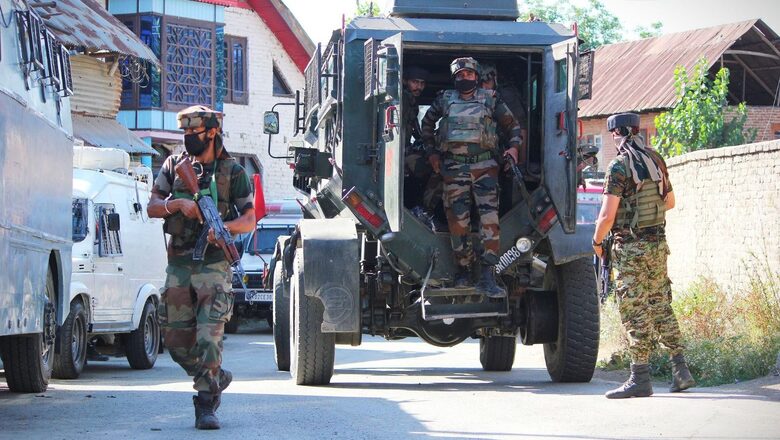
views
A chain of events has occurred in Jammu and Kashmir (J&K) since the start of this year. Four civilians were shot dead as part of targeted killings in Rajouri’s Dangri in the first week of 2023. Two others later succumbed to injuries. The very next day, an IED blast at the same spot left two more children dead. An immediate security retaliation followed the killing of two of the suspected perpetrators and a country-wide ban on two fairly “new” terror outfits — The Resistance Front (TRF) and People’s Anti-Fascist Forces (PAFF). This country-wide ban triggered a spontaneous response from the TRF, warning against such measures, along with the issuance of a fresh ‘hit list’ of targeted killings.
It is noteworthy that in the backdrop of the changing security dynamics following the internal reorganisation of Jammu and Kashmir, both these groups emerged as representing the “new,” “indigenous,” and “secular” face of militancy in J&K. Visible attempts at establishing this “new militancy” as distinct from Islamist leanings has since raised questions surrounding a possible “secularisation of militancy” in the UT. The statement released as a response to this country-wide ban reflects similar attempts. It categorically denies any alleged linkages with the Lashkar-e-Taiba (as alleged by security agencies) along with the alleged communal element of their targeted killings. However, abject contradictions on ground raise questions surrounding the veracity of this claimed “newness” on several fronts. It becomes crucial to revisit the political dynamics under which these groups emerged, in this context.
The internal organisation of J&K was coupled with a massive security crackdown on external conduits of support to militancy in the region. This included tapping free of funds, supplies, and infiltration bids inside J&K, thus leaving the existing terror networks facing a major crunch of resources for operation. Their desperation was witnessed in terms of using tunnels, drones, and contraband smuggling in this intervening time. As these groups declined in prominence, the emergence of newer groups was noticed, most prominently since 2020. These new groups reflected a break from the Pakistan-sponsored, Islamist image of militancy to a more indigenous, secular “movement for independence.” The emphasis seemed to be shifting from the idea of an Islamic jihad to a “Kashmiri Resistance” against a “Fascist regime” or the “occupying forces” (referring to the Indian state). The assertion of their indigenous roots and de-linkage from previously existing Islamic terrorist outfits, namely Lashkar-e-Taiba, Jaish-e-Mohammed, etc, was publicised as the distinct characteristic of these new groups through their choice of terminology in public messaging, pamphlets, and justifications for acts of terror.
If examined, one realises that these facts have held some truth. From the names of these new organisations to the logos, as well as their official statements reflect a deliberate attempt to assert their indigenous and secular element. The most recent pamphlet released on January 7, 2023, reiterates the same sentiment, noting that the “TRF is an indigenous armed group having affiliation with no other armed group active in IIOJK” and that “we (they) don’t have personal animosity with anybody irrespective of their religion or culture but once he or she tries to become a pawn of this Fascist regime, is automatically a target of our (their) bullets.” It must be recalled that dissociating from any communal motivations, a similar line of reasoning was applied to justifying the killing of Kashmiri chemist Makhal Lal Bindroo in 2022 or the school principal Supinder Kour in 2021. While Bindroo was identified as a government stooge, the school principal with another Kashmiri Pandit teacher were targeted for “politicisation of the education sector.”
However, dug deeper, the pattern of activities on ground reflects grave contradictions. To begin with, each of the seven civilians targeted in Rajouri identified as Hindus. It has been reported that the militants “checked the Aadhar cards to ascertain identity.” If recalled, these claims were previously reported by civilians during the killing of Supinder Kour and Deepak Chand also. A whole range of killings traced at least in the past two years reflects a similar pattern. While these killings comprised a significant number of victims identifying as Muslims, Kashmiri and otherwise, each of them appears to be driven by direct political motivations — of being members of the Panchayats, local leaders of the BJP, etc. Each of them seems to have been targeted by virtue of their association with the state as opposed to their virtue of identifying as Muslims. Tracing the major incidents of violence in this time duration becomes pertinent in this context.
Railway Constable Bantu Sharma shot dead in Kulgam
Makhanlal Bindroo, Kashmiri Pandit chemist shop owner killed in Srinagar
Virendra Paswan, chaat seller from Bihar killed in Srinagar
Mohd Shafi Lone, President of cab drivers’ association killed in Naidkhai area of Shahgund
School principal Supinder Kour and teacher Deepak Chand shot dead in school in Srinagar
Two labourers Raja Reshi Dev and Joginder Reshi Dev shot at in Kulgam
TRF
ULF
Arvind Kumar Sah, labourer from Bihar, shot dead in Srinagar
Sagir Ahmed, labourer from UP, gunned down in Pulwama
Vijay Kumar, a bank manager at Ellaquai Dehati Bank, hailing from Rajasthan killed inside his office
Two migrant labourers shot in Budgam’s Chadoora. One of them identified as Dilkhush (resident of Bihar) dies
Source: Data compiled by author from news reports
Moreover, the links found between the “new militant” outfits and those previously existing appear even more plausible given the disparity between the recruitment numbers and the number of incidents owned by these new outfits. While the recruitments continue to remain meagre, a majority of incidents involving civilian casualties have been owned by them, especially the TRF. A valid question thereby is that if these outfits are not functioning as fronts for the Islamist groups, how are they executing major incidents of killings without sufficient recruitment? Additionally, it is noteworthy that most aforementioned incidents were all claimed by these new outfits, and those ascribed to the old ones were identified by investigations by security agencies. None of these groups claimed any attack by themselves.
Each of these observations hints at two things. One, the character of militancy in the UT seems to have deliberately distanced itself from pre-existing Islamic tendencies, while its essence continues to remain communal. Two, as alleged by security agencies, this phenomenon is being executed through new outfits, possibly covering for the previously existing outfits under severe government crackdown and international scrutiny. The reasons behind this deliberate distancing appear obvious in the current context. Apart from desperation among militants following the security crackdown since 2019 as aforementioned, the rise of India’s stature in recent years is an aspect worth considering. This has been reflected such that the abrogation of Article 370 found no major critics including among the Organisation of Islamic Cooperation (OIC) countries, which was a major setback in terms of international support from the Islamic world. The economic turmoil being faced by Pakistan only adds to the apathy. The recent lifting of the Financial Action Task Force (FATF) sanctions has offered a long-awaited breather to Islamabad, which it might want to preserve, at least in the short run, given the international support it seeks for its economic revival. Moreover, international frustration against Islamist terrorism has been growing, especially in the West.
This particularly becomes important to recognise at this juncture when the organisations possibly designated to “cover” the previously existing Islamist character have come under a nationwide ban following events in the first week of January 2023. By inference, the militancy in J&K appears certainly “new” in its appearance, however, this “newness” must be, at best, understood as adaptation and improvisation to the current politico-security dynamics instead of a break from the previously existing scenario in terms of ideology, essence, and core motivations. How this ban shall impact the face of militancy and its attempted “newness” in Jammu and Kashmir would be crucial to watch.
Tejusvi Shukla is an independent security analyst. She has served as a Research Assistant with the Centre for Land Warfare Studies between May 2019 and November 2020. She has also previously interned at the Manohar Parrikar Institute of Defense and Strategic Analyses. Views expressed are personal.
Read all the Latest Opinions here

















Comments
0 comment